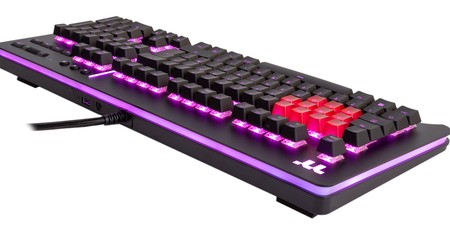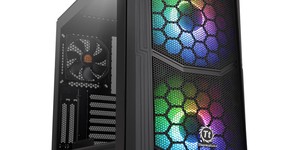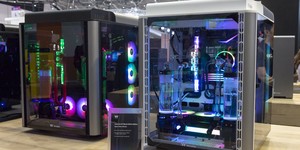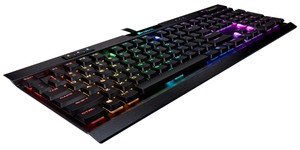Thermaltake Level 20 RGB Mechanical Gaming Keyboard Review
April 16, 2019 | 14:00
Companies: #thermaltake

Manufacturer: Thermaltake
UK price (as reviewed): £154.99 (inc. VAT)
US price (as reviewed): $149.99 (exc. tax)
Thermaltake is probably not the first company you think of when it comes to premium keyboards, but along with Corsair and Razer it’s certainly one which has embraced RGB the most. The Level 20 RGB Mechanical Gaming Keyboard (hereafter MGK – no association with the tatted-up mumble rapper) is further proof of this and the first non-chassis product in the company’s arsenal to join the Level 20 family. Its price tag puts it in line with fierce competition, so let’s see how it measures up.

Literally speaking, it measures up rather large. As well as a full-size key layout, the Level 20 RGB MGK has a chassis which extends far past the key edges on all four sides, making it 482mm wide and 186mm deep. The trend these days is to keep keyboard frames to a minimum, and I personally don’t gel with the bulk here, but you certainly might, and it’s at least in line with the Level 20 cases’ big and bold aesthetic.

I can’t argue with the build quality; this is a serious 1.5kg slab of keyboard. A 2mm black anodised aluminium faceplate (there’s also a silvery ‘Titanium’ version) adds rigidity, and the raised keycap design complements it well.

Large rubber pads on the underside provide plenty of grip, and the flick-out hind legs are two-tiered, meaning you get three possible typing angles to choose from. Although plastic, these legs are surprisingly sturdy and easily among the better designs I’ve seen, especially as both parts also have rubber tips so as to not compromise the grip when using them.

I’m also pleased to note that Thermaltake is using a full set of Cherry MX switches. Your options with the Level 20 RGB MGK are Cherry MX Blue RGB or Cherry MX Speed Silver RGB. Ours has the latter, and this version has a small price premium. As a reminder, Speed Silvers have the same linear action (no click, no bump) as Red switches and the same light actuation force of 45cN, but they have a shorter actuation point (1.2mm versus 2mm) and shorter total travel (3.4mm versus 4mm). The aim of course is to make the keys faster to actuate, giving companies like Thermaltake an obvious point of marketing for gaming.

In practice, I found it hard to notice any obvious speed increase, although the shorter travel distance is perceptible if you tend to bottom out. Still, the light, linear action is certainly straightforward and works particularly well in games. As usual for Cherry, consistency across the keys feels excellent. Although there’s no click within the switches, there’s still the usual mechanical clacking noise as you hammer away, sometimes accentuated by a metallic twang from the metal plate, though that’s usually only when you slam the spacebar. In short, the Thermaltake Level 20 RGB MGK is very satisfying to use.

The thick 1.8m braided cable is non-detachable, which is a shame, but it is at least fixed firmly. It bundles a bunch of connectors into a single cable to offer pass-through functionality for a lone USB 2.0 port and a combined headphone/microphone audio jack. This approach feels outdated after seeing Cooler Master’s MK850, where a single detachable USB 3.0 cable is used and still offers a pass-through port, but the ports will still be nice features for many.
Unfortunately, you do not get a wrist rest with the Level 20 RGB MGK. Admittedly, this would make the desk footprint comically big, but I did miss having one.

The keycap font is clear if a little small. Replacement bright red keycaps are supplied for the gaming-centric keys 1-4, QWER, and ASD. However, only their colour is different rather than their contour and/or texture too. I’ve never seen much appeal in replacement caps like these (wrist rest instead, please!), and these ones look naff when illuminated. Thermaltake goes with standard sizes for all keys, so you could easily replace the full set if you wished. The key puller is useful regardless, as it will speed up cleaning.

The dedicated media keys in the top right are handy, but they’re undeniably Corsair-inspired. That said, the volume wheel is plastic rather than metal, and it doesn’t feature click-to-mute. To the left of these you have the three lock indicator lights, and dedicated keys for Windows key lock, brightness control (five levels and off, and what I believe is a button to enable smartphone pairing.

Without software, the Thermaltake Level 20 RGB MGK is unable to take full advantage of its feature set, but there’s a decent amount of plug and play functionality. With the FN key, you can access some key Windows shortcuts, change the lighting though 11 effects (plus off), and even alter the speed and RGB channels for these effects where relevant. In terms of lighting control, this portion of the keyboard is one of the most intuitive I have come across – something I gauge based on my never having to consult a manual or guide to figure it out. It was very easy to correct a slightly red tint on a white setting, for example. It’s also possible to lock the keys completely and to have lighting patterns display on specific gaming keys only – all from the hardware.

There are also macro/LED recording buttons, presumably for setting custom functions and lighting patterns on-the-fly, but neither would work for me. Likewise, there’s no ability to switch between profiles until you use the software.

This being Thermaltake, the RGB lighting doesn’t end with the keys. The TT logo in the top-left gets some 16.8 million colour loving, as does the vertical strip to the right of the Enter key. There’s more still, as a continuous strip runs along both sides and the back edge. The strip also continues along the front edge but here it is not directly illuminated. Essentially, whatever angle you examine the Level 20 RGB MGK from you’ll find some RGB.

MSI MPG Velox 100R Chassis Review
October 14 2021 | 15:04








Want to comment? Please log in.